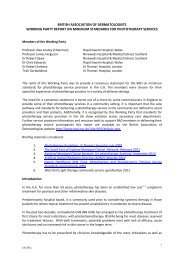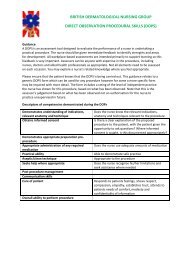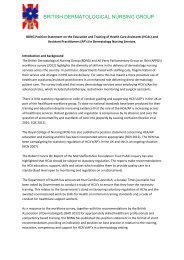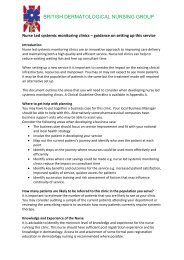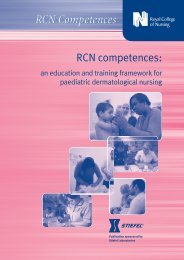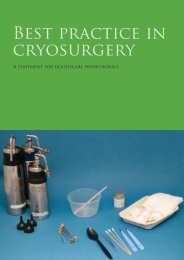Improving outcomes for people with skin tumours including melanoma
Improving outcomes for people with skin tumours including melanoma
Improving outcomes for people with skin tumours including melanoma
You also want an ePaper? Increase the reach of your titles
YUMPU automatically turns print PDFs into web optimized ePapers that Google loves.
<strong>Improving</strong> Outcomes <strong>for</strong><br />
People <strong>with</strong> Skin Tumours<br />
<strong>including</strong> Melanoma<br />
Initial investigation,<br />
diagnosis, staging and<br />
management<br />
Radiotherapy is curative <strong>for</strong> some cases of advanced inoperable<br />
disease. Radiotherapy also has a role in the palliative treatment<br />
of patients <strong>with</strong> large, inoperable and recurrent SCC, or if there<br />
are inoperable metastases in lymph nodes or elsewhere.<br />
Radiotherapy has a role in adjuvant treatment of extracapsular<br />
nodal disease following neck dissection, <strong>for</strong> example, and not<br />
just palliation.<br />
• Systemic treatment. There are very few patients <strong>with</strong> NMSC<br />
who need systemic treatment <strong>with</strong> chemotherapy.<br />
A. Recommendations<br />
Investigation and diagnosis<br />
4<br />
GPs should receive training as recommended in the NICE Referral<br />
guidelines <strong>for</strong> suspected cancer 44 on the diagnosis of precancerous<br />
and cancerous lesions, and should receive feedback through audit on<br />
their diagnostic accuracy.<br />
GPs should refer certain groups of <strong>skin</strong> lesions as described in Box 1<br />
and Figure 14 directly to an LSMDT <strong>with</strong>out biopsy. This practice<br />
should be subject to audit.<br />
All excised <strong>skin</strong> specimens should be sent <strong>for</strong> histopathological<br />
examination as recommended in the NICE Referral guidelines <strong>for</strong><br />
suspected cancer. 45<br />
Dermatoscopy should be available in all MDTs, but its use requires<br />
training.<br />
There should be equity of access so that all tissue samples are<br />
reviewed in high-quality histopathology services. Accurate diagnosis<br />
in dermatopathology depends on clinicopathological correlation,<br />
involving input from both clinician and pathologist. Although this can<br />
be achieved in difficult cases by interspecialist discussion or seeing<br />
the patient records, in some instances (such as cutaneous lymphoma)<br />
it may be essential <strong>for</strong> the patient to be seen jointly. Accordingly, <strong>for</strong><br />
good clinical governance, it is recommended that the histopathology<br />
reporting of any specimens likely to be considered by a <strong>skin</strong> cancer<br />
MDT should be undertaken in a laboratory having easy access to<br />
relevant clinicians, patient records and the attending patient.<br />
44 National Institute <strong>for</strong> Health and Clinical Excellence. Referral guidelines <strong>for</strong> suspected<br />
cancer. Available from: www.nice.org.uk/CG027<br />
45 National Institute <strong>for</strong> Health and Clinical Excellence. Referral guidelines <strong>for</strong> suspected<br />
cancer. Available from: www.nice.org.uk/CG027<br />
84<br />
National Institute <strong>for</strong> Health and Clinical Excellence




